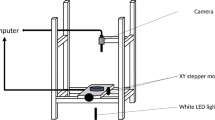Abstract
An attempt is made at a unified morphological analysis of the hyphomycetous anamorph as seen in its two phenotypic expressions: the vegetative (=hyphae and mycelia) and the reproductive (=conidiophores, conidiogenous cells, proconidia and free propagules). (Multi-hyphal structures are ignored). A distinction is made between cytological and structural criteria. The basic units used arecells (or compartments), and their assemblage intohyphae, and at a higher level of organization,organs. The description ofelements (=the simplest recognisable structures) is suggested for cases where compartments are absent or poorly defined. Eight independent characters are proposed for the description of the mature anamorph. A unified approach is also suggested for the study of the development of the anamorph. Basic, general processes are growth (=different combinations of elongation, branching and transformation), maturation, lysis and secession (as defined in this paper), and, in the case of recognizable compartments, cell division (=septation). These processes, when integrated in various specific sequences, result in well known patterns, seen in both vegetative development and asexual reproduction. Examples are drawn from species with ameroconidia, more intensively studied in recent literature, as well as on lesser known species with simple, septate, or compound conidia. Some criteria are proposed for an ordered observation of independent processes which could provide a basis for a more stable descriptive terminology.
Similar content being viewed by others
References
Bandoni R J 1974 Mycological observations on the aqueous films covering decaying leaves and other litter;Trans. Mycol. Soc. Jpn. 15 309–315
Barron G L 1972The genera of hyphomycetes from soil (New York: Krieger Pub. Co.)
Beverwijk A L van 1951 Zalewski’sClathrosphaera spirifera;Trans. Br. Mycol. Soc. 34 280–290
Chesters C G C 1968 Morphology as a taxonomic criterion. InThe Fungi; an advanced treatise. (eds) G C Ainsworth and A S Sussman (London: Academic Press) vol. III, 517–542
Clutterbuck A J 1970 Synchronous nuclear division and septation inAspergillus nidulans;J. Gen. Microbiol. 60 133–135
Cole G C and Samson R A 1979Patterns of development in conidial fungi (London: Pitman).
Deighton F C 1976 Studies onCercospora and allied genera, VI;Commonw. Mycol. Inst. Mycol. Pap. 140 1–168
Descals E, Nawawi A and Webster J 1976 Developmental studies inActinospora and three similar aquatic hyphomycetes;Trans. Br. Mycol. Soc. 67 207–222
Ellis M B 1971Dematiaceous Hyphomycetes (Kew: Commonw. Mycol. Inst.)
Fiddy C and Trinci A P J 1976 Mitosis, septation, branching and the duplication cycle inAspergillus nidulans;J. Gen. Microbiol. 97 169–184
Griffin D H 1981Fungal Physiology (New York: John Wiley)
Hammill T M 1981 Conidiogenesis. InThe Fungal Spore: morphogenetic controls (eds) G Turian and H R Hohl (New York: Academic Press) 151–171
Hoog G S 1974 The generaBlastobotrys, Sporothrix, Calcarisporium andCalcarisporiella gen. nov. Baarn, Centraalbureau voor Schimmelcultures.
Hughes S J 1951 Studies on microfungi VII;Commonw. Mycol. Inst. Mycol. Pap. 41 1–17
Hughes S J 1953 Fungi from the Gold Coast. II;Commonw. Mycol. Inst. Mycol. Pap. 50 1–104
Hughes S J 1978 New Zealand Fungi, 25. Miscellaneous species;N. Z. J. Bot. 16 311–370
Ingold C T 1975 Convergent evolution in aquatic fungi: the tetraradiate spore;Biol. J. Linn. Soc. 7 1–25
Kendrick B 1971 Conidium shape. InTaxonomy of Fungi Imperfecti (ed.) B Kendrick (Toronto: Univ. of Toronto Press) 301–304
Kendrick B and Nag Raj T R 1979 Morphological terms inFungi Imperfecti. InThe Whole Fungus; the sexualasexual synthesis (ed.) B Kendrick (Ottawa: Nat. Mus. of Nat. Sci. and Kananaskis Foundation) 43–61
Madelin M F 1981 Ultrastructural morphogenesis in higher fungi; discussant’s introduction. InThe fungal spore; morphogenetic controls (eds) G Turian and H R Hohl (New York: Academic Press) 95–106
Marchant R 1979 Wall growth during spore differentiation and germination. InFungal walls and hyphal growth (eds) J H Burnett and A P J Trinci (Cambridge: C.U.P.) 115–148
Marvanová L 1975 ConcerningGyoerffyella Kol;Trans. Br. Mycol. Soc. 65 555–565
MacLaughlin D J 1977 Basidiospore initiation and early development inCoprinus cinereus;Am. J. Bot. 64 1–16
Minter D W, Sutton B C and Brady B L 1983 What are phialides anyway?;Trans. Br. Mycol. Soc. 81 109–120
Prosser J I 1979 Mathematical modelling of mycelial growth. InFungal walls and hyphal growth. (eds) J H Burnett and A P J Trinci (Cambridge: C.U.P.) 359–384
Prosser J I and Trinci A P J 1979 A model of hyphal growth and branching;J. Gen. Microbiol. 111 153–164
Robertson N F 1958 Observations on the effect of water on the hyphal apices ofFusarium oxysporum;Ann. Bot. London 22 159–173
Robertson N F 1959 Experimental control of hyphal branching and branch form in hyphomycetous fungi;J. Linn. Soc. Bot. 56 207–211
Smith J E 1978 Asexual sporulation in filamentous fungi. InThe filamentous fungi (eds) J E Smith and D R Berry (London: E. Arnold) vol.3 214–239
Smith J E and Berry D R 1974An introduction to biochemistry of fungal development (London: Academic Press)
Stearn W T 1973Botanical Latin (Newton Abbot: David and Charles)
Sutton B C 1980The Coelomycetes (Kew: Commonw. Mycol. Inst.)
Trinci A P J 1978 The duplication cycle and vegetative development in moulds. InThe filomentous fungi (eds) J E Smith and D R Berry (London: E. Arnold) vol3 132–163
Trinci A P J 1984 Regulation of hyphal branching and hyphal orientation. InThe ecology and physiology of the fungal mycelium (eds) D H Jennings and A D M Rayner (Cambridge: C.U.P.) 23–52
Webster J and Davey R A 1984 Sigmoid conidial shape in aquatic fungi;Trans. Br. Mycol. Soc. 83 43–52
Webster J, Nawawi A and Descals E 1975Spore development in aquatic hyphomycetes 16 mm ciné film, Univ. of Exeter, Great Britain.
Author information
Authors and Affiliations
Rights and permissions
About this article
Cite this article
Descals, E. Conidia as modified hyphae. Proc. Indian Acad. Sci. 94, 209–227 (1985). https://doi.org/10.1007/BF03053138
Issue Date:
DOI: https://doi.org/10.1007/BF03053138




